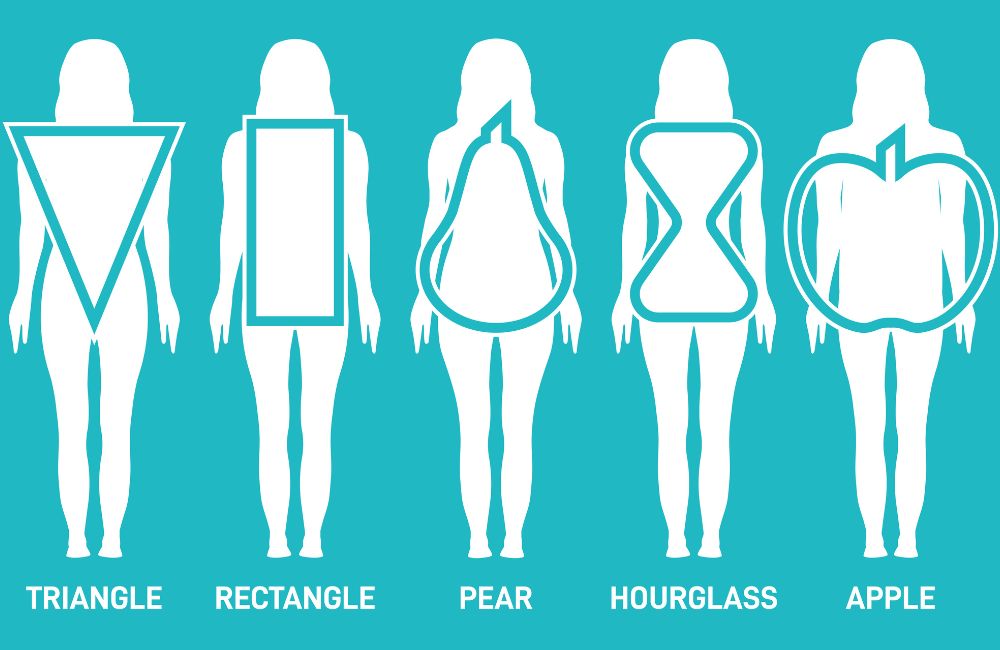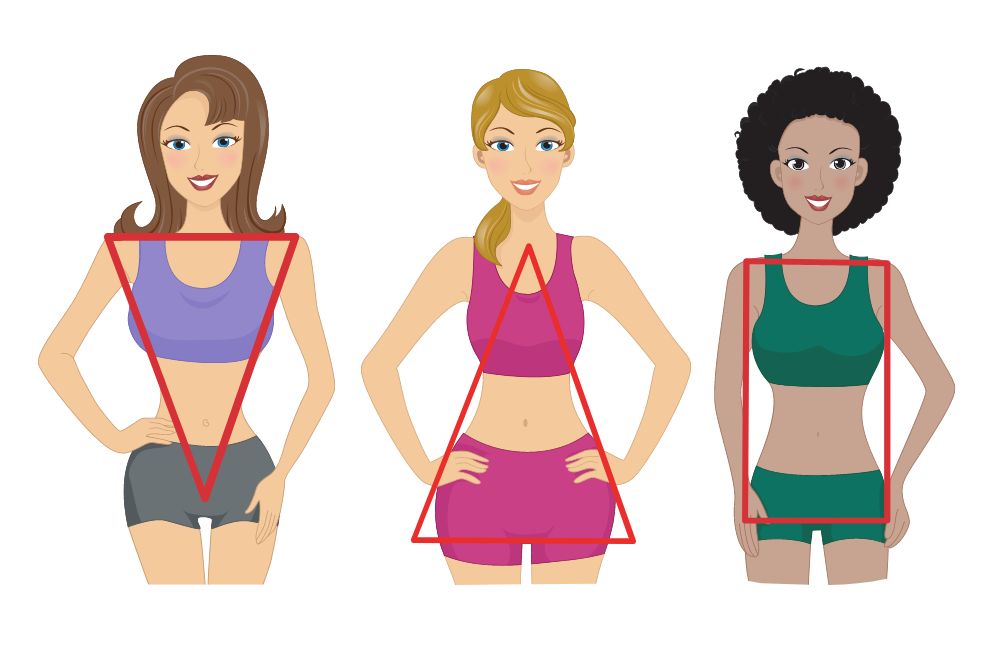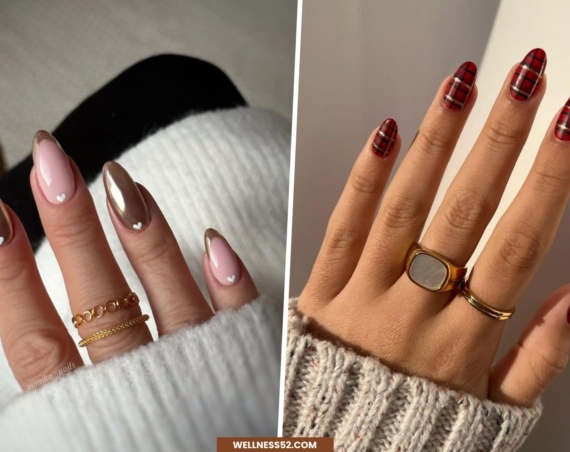
If you’ve always heard about different body shapes but were never quite sure where you fit in, this article is for you! The Body Type Calculator is designed to help women find their body shape, which can be useful in getting targeted outfit ideas.
What Is Your Body Shape?

This calculator will tell you about the basic body shapes and if your figure resembles more of an hourglass, rectangular, triangle, or downward triangle. We’ll also tell you if you are an endomorph, ectomorph, or mesomorph. Don’t worry, we’ll explain it more later!
This body type calculator gives you the answer instantly with just a few body measurements. It provides measurements for the four most common female body types: pear, apple, straight, and hourglass.
So if you’ve ever wondered what body type you are, this calculator will tell you in a matter of seconds, and all you need is some measuring tape.
Though it’s reliable for different body shapes, it’s not intended to be a serious indicator of health or health risk.
If you are more concerned about health risks, I would recommend looking at the waist-hip ratio (WHR) or body mass index (BMI). These two measurements provide a lot more information about different health factors.
Below we’ll go over how to measure your body so you can get the most accurate results.
You may also like:
The Three Male Body Types: Ectomorph, Mesomorph, Endomorph
7 Exercises That Will Transform Your Whole Body in Just 4 Weeks
How to Take Measurement
In order to determine your body type with this body shape calculator, you will need four different measurements. Use a measuring tape to determine the measurements of the following areas of your body.
- Bust: make sure to measure the fullest part of your bust.
- Waist: the circumference of the smallest part of your torso, right above the belly button
- High hip size: the upper curve of the hip
- Hip size: the widest point of your buttocks below your waistline
Measurement Guidelines
In order to get accurate measurements, make sure to use a flexible tape measure that shows either inches or centimeters. If you don’t have a measuring tape, you could also use a piece of string that you can then measure with a ruler.
Getting an accurate measurement is key, so make sure to double-check your work.
You can either have someone else help you, or take body measurements yourself by standing in front of the mirror to ensure the measuring tape is in the right place.
Make sure you are standing up straight and wrapping the measuring tape around the desired area, ensuring it is not too tight or too loose.
How to Measure Bust Size
The first step is measuring bust size. Use a flexible tape measure and wrap it around your torso directly under the breasts.
The tape measure should essentially be sitting where a bra band would sit. This is best done while braless or at least not wearing a padded bra.
How to Measure Waist Size
To measure the size of your waist, wrap the tape measure around your natural waistline. This should be the smallest part of your waist. This is normally just above the belly button.
How to Measure High Hip Size
The high hip measure should be about 3-4 inches below the waistline. This is close to the top of your hip bone, around where the waistband of a pair of pants would sit.
How to Measure Hip Size
Hip size is measured by wrapping the measuring tape around the fullest part of your hip, below your hip bone. This should be the area where your butt protrudes the most.
7 Female Body Shapes
Now that you have your measurements for your entire body, our body shape calculator can help you determine your body type from the four most common female body types.
Remember that everybody is different, so everyone will fall into a different body type, and even those with the same body type may wear a different clothing size or look quite different.
Someone with one body type may have a fuller figure, while someone with the same type has a small frame.
While the fashion industry may only show us, fashion models, with one body type, rest assured that there are clothes out there that are flattering, no matter what your proportions.
Inverted Triangle (Apple Shape)
Those that fall into the Apple Shape body type have broader shoulders and bust and more narrow hips. The midsection may not necessarily be the fullest part of your torso, but it is likely not very defined.
If your preference is to create more of an hourglass figure, we recommend dresses and clothing that cinch the waistline and provide more structure to the shoulders and bust.
Rectangle (Banana, Straight)
This body shape describes a person who typically has waist measurements that are less than 9 inches smaller than the hip or bust measurements. In other words, the narrowest part of your waist is fairly similar to your shoulders and hip measurements.
To create the illusion of curves, we recommend finding tops, skirts, and pants that accentuate the natural waist.
Triangle (Pear Shape)
The Pear Shape describes a person who has a hip circumference greater than their bust measurements.
We recommend tops and dresses that accentuate the top half of your body. For example, waist-defining tops or tops with flowy fabric. If showing off your curves on the bottom half of your body is what you desire, try the slim fit and straight-cut pants.
Hourglass shape
The hourglass shape describes a person with hip circumference and breast that are nearly equal in size, with a narrower waist measurement. This is likely what you think of when you describe “curves”.
An hourglass figure looks great with more fitted and structured tops. Dresses, skirts, and pants that cinch in at the waistline are most flattering.
Bottom Hourglass
For this body type, you still have a narrower waist, but your waist-hip ratio is slightly larger than your breast-hip ratio, meaning your hips tend to be your widest part.
Top Hourglass
For this body type, as with the one above, you still have a narrower waist, however, your breast-hip ratio is slightly larger than your waist-hip ratio.
Spoon
The spoon body type is pretty similar to the triangle or “pear” shape. The hips tend to be your largest measurement, with a narrower, defined waist. You may also carry some weight in your upper arms and upper thighs.
What Is the Most Common Body Shape?
A study of more than 6,000 women conducted at North Carolina State University in 2005 revealed that 46% of women were rectangle-shaped; just over 20% were pear-shaped; just under 14% had an apple shape, and only 8% were hourglass-shaped.
While this study revealed the most common body shape, remember that your body shape is not necessarily an indicator of health risks or health problems.
This body shape indicator simply looks at your physiology to help you find your body type so you can think about things like what clothes or workouts work best for you.
What Is My Body Shape?
Now it is time to take those body measurements and find out your body shape.
The body shape calculator will help you determine your body shape as one of seven different types based on your body composition.
The algorithm in the calculation is derived from a study published in the International Journal of Clothing Science and Technology.
Remember, there is a wide range of body sizes in each shape, so it’s totally normal to look different than someone with the same shape as you.
Your body type does not determine how much fat you have or what size clothes you wear.
To determine the shape of your body, take a look at this size chart:
Somatotype Body Types
A different way to look at body proportions is somatotypes.
While the calculations we’ve covered so far are better indicators of the silhouette and shape of your body, somatotype is more about how your body deals with weight gain and muscle.
If your preference is to learn more about how your body stores fat or build muscle, you will enjoy this measurement. There are three different types:
Endomorph
The first type is the endomorphs. They tend to have a softer, rounder, and stockier physique.
They can find fat loss challenging because they do tend to have a slower metabolism. It can also be difficult for them to increase muscle mass. Endomorphs tend to have wide hips and shorter limbs.
It is recommended that endomorphs reduce carbohydrates in their diet and focus on lean protein and produce. They can also develop a good physical activity routine in the form of both cardio and strength training in order to get and stay lean.
Mesomorph
The second somatotype is mesomorph. Those with the mesomorph body type have your classic athletic body. They tend to have larger bone structure and average metabolism and can gain muscle mass and build definition fairly easily.
Mesomorphs tend to do best on a diet focused on lean protein and lower in carbs. While this doesn’t make them healthier than other body types, they do tend to bounce back into shape more quickly.
Because they build muscle quite easily, cardio is a good focus for mesomorphs looking to stay lean.
Ectomorph
Ectomorphs are usually skinny, lean, or thinner. They have a fast metabolism, which makes weight gain difficult for them. It can also be challenging to build muscle.
Because ectomorphs have a hard time building muscle, they should focus on nutrient-dense foods that aid in weight and muscle gain. Ectomorphs should avoid processed carbohydrates, and get their carbs from foods like whole grains, fruits, and vegetables.
They should also focus on strength and resistance training while keeping cardio to a minimum.
What Is a Healthy Waist Size?
While the body shape calculator is just a screening tool for different body shapes, there are other calculations that can be better predictors of higher health risks.
Both BMI and WHR can be good indicators of a higher risk for health problems.
For example, there have been studies on the ideal size of the waist, based on risks for different health conditions such as hypertension and heart disease.
Many of these indicators are based on sex, so risk factors are different for men and women.
New research from the World Health Organization, a waist circumference greater than 40 inches (102 centimeters) for men, and 35 in (88cm) for women puts you in the obesity category.
According to the WHR, obesity is greater than 0.9 in men, and 0.85 in women. Obesity is also indicated by having a BMI of greater than 30. Because of this, the ideal waist size based on health risk is 32.5 inches (82.5 cm) for women.
As a dietitian, I do like to use the WHR, because it accounts for abdominal fat, rather than just weight. A large waist circumference can put you at a higher risk for things like cardiovascular disease, hypertension, and chronic diseases.
Those who do fall into the category of obese are at a higher risk for things like heart disease, high cholesterol, and high blood pressure. Obesity can also cause things like pain in the joints and trouble doing daily tasks.
What Affects Your Body Shape?
Several different elements help determine your body type. The first is genetics, which can play a role in a few ways.
The first is that genetics determine how you accumulate and store body fat. Some people hold body fat in their thighs and buttocks, while others will hold fat more around their abdomen.
Where your body naturally stores that fat is going to be based on your genetics.
Genes also play a large role in bone structure, which is another determinant of body type.
For example, some people have wide hips or longer legs, while others might have a small frame or shorter limbs. The curve of your spine can also impact the curves of your body or how you hold yourself.
Genes also play a role in the sense that body type differs a lot based on gender and ethnicity. Women tend to hold more weight in the thighs, butt, and lower abdomen. While men hold a lot of their weight in the midsection. Ethnic differences can also impact where your body tends to store fat.
Hormones can also play a big role in your body shape. When you are stressed, the hormone cortisol is released.
This has been shown to cause your body to store more fat in the abdomen. Hormones relating to fertility, like estrogen have also been shown to cause more body fat storage in the lower abdomen.
This is why women tend to put on some weight during menopause or puberty when their estrogen levels are changing.
Does Your Body Shape Change When You Lose Weight?
By losing weight, you can change the appearance of your body shape. For example, where you see that weight loss will likely depend on your sex.
Since females store more fat in the thighs, waist, and abdomen, they will likely lose weight in those areas, making them appear less “curvy”. While males tend to store most of their fat in the stomach and can usually build muscle more easily.
For women, the shape of their bodies can change throughout their life as well. For example, menopause and puberty, or other times of changing estrogen, can be times that your body can change the way it stores fat.
While you can change the appearance of your body, you cannot change your somatotype. Somatotype is largely based on bone structure, genetics, and sex. While you can build muscle and lose body fat, how you store fat in the future will not change.
Last Words
We hope this calculator has given you a better idea of your body shape. Always remember that the shape of your body is not an indicator of health risks. No one particular shape is the illustration of health. By eating a healthy diet and being physically active, any body type can live a healthy life.
If you do want to learn more about your health risks based on your waist circumference, make sure to take a closer look at the WHR (waist to hip ratio) for a better guideline.
We hope that providing some diet and exercise tips, as well as outfit ideas can help you improve your body image and feel confident no matter what your waist measurement.


